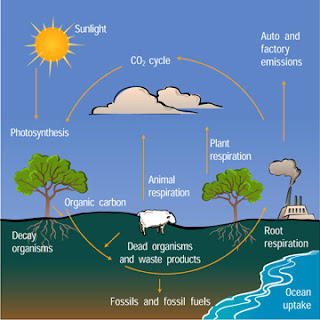Wednesday, July 11, 2012
The carbon cycle is the biogeochemical cycle by which carbon is exchanged among the biosphere, pedosphere, geosphere, hydrosphere, and atmosphere of the Earth. It is one of the most important cycles of the Earth and allows for carbon to be recycled and reused throughout the biosphere and all of its organisms.
1st Process of Carbon and Oxygen Cycle
Photosynthesis
- green plants/trees take in carbon dioxide and water using the chlorophyll In their leaves and energy from the sun they release oxygen, sugar and water vapor.
2nd Process for Carbon and Oxygen Cycle
Respiration
- animals take in simple sugars and oxygen and release carbon dioxide, water and energy.
- animals take in simple sugars and oxygen and release carbon dioxide, water and energy.
3rd Process for Carbon and Oxygen Cycle
Combustion
- the sequence of exothermic chemical reactions between a fuel and an oxidant accompanied by the production of heat and conversion of chemical species. The release of heat can result in the production of light in the form of either glowing or a flame. Fuels of interest often include organic compounds (especially hydrocarbons) in the gas, liquid or solid phase.
4th Process for Carbon and Oxygen Cycle
Decmposition
-when an animal dies, all the carbon, oxygen, nitrogen, calcium etc. return to the soil and air during deomposition.
-when an animal dies, all the carbon, oxygen, nitrogen, calcium etc. return to the soil and air during deomposition.
Oxygen Cycle
Almost all living things need oxygen. They use this oxygen during the process of creating energy in living cells.
Just as water moves from the sky to the earth and back in the hydrologic cycle, oxygen is also cycled through the environment. Plants mark the beginning of the oxygen cycle. Plants are able to use the energy of sunlight to convert carbon dioxide and water into carbohydrates and oxygen in a process called photosynthesis.

Animals form the other half of the oxygen cycle. We breathe in oxygen which we use to break carbohydrates down into energy in a process called respiration.

Just as water moves from the sky to the earth and back in the hydrologic cycle, oxygen is also cycled through the environment. Plants mark the beginning of the oxygen cycle. Plants are able to use the energy of sunlight to convert carbon dioxide and water into carbohydrates and oxygen in a process called photosynthesis.
Animals form the other half of the oxygen cycle. We breathe in oxygen which we use to break carbohydrates down into energy in a process called respiration.
Oxygen in Water
Oxygen in water is known as dissolved oxygen or DO. In nature, oxygen enters water when water runs over rocks and creates tremendous amounts of surface area. The high surface area allows oxygen to transfer from the air into the water very quickly.
When the water in a stream enters a pond, microorganisms in the pond begin to metabolize (break down) organic matter, consuming oxygen in the process. This is another form of oxygen cycle - oxygen enters water in rapids and leaves water in pools.
Carbon Cycle
The carbon cycle is one of the biogeochemical cycles. Plants absorb CO2 from the atmosphere during photosynthesis, also called primary production, and release CO2 back in to the atmosphere during respiration. Another major exchange of CO2 occurs between the oceans and the atmosphere. The dissolved CO2 in the oceans is used by marine biota in photosynthesis.
Two other important processes are fossil fuel burning and changing land use. In fossil fuel burning, coal, oil, natural gas, and gasoline are consumed by industry, power plants, and automobiles. Notice that the arrow goes only one way: from industry to the atmosphere. Changing land use is a broad term which encompasses a host of essentially human activities. They include agriculture, deforestation, and reforestation.
Subscribe to:
Comments (Atom)




